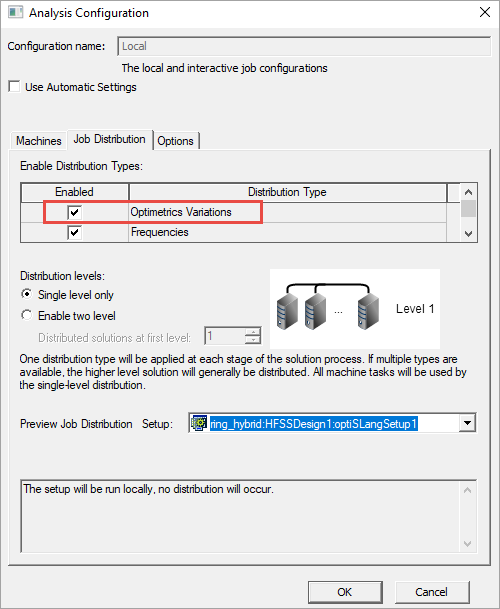Example optiSLang Setups
The following are example scenarios illustrating different considerations that might be taken when preparing an optiSLang setup. See: Solving an optiSLang Setup.
Settings in these examples are handled both in AEDT and in optiSLang.
Example 1: Solving a User-created, Pre-existing optiSLang Setup
Recall that optiSLang setups are handled as Optimetrics setups in AEDT.
By preparing an optiSLang setup in an AEDT project, you can create regular DSO jobs even though the AEDT integration node is left in the single simulation run mode. In every design folder, the clone of the reference project contains the optiSLang setup and its solution is triggered under the Analyze All umbrella. Depending on the HPC settings active in AEDT for the model type in question, this yields optiSLang DSO jobs.
A key setting is the check box for enabling Optimetrics Variations in the Job Distribution tab of the Analysis Configuration window:

The Use Automatic Settings check box must be disabled to view this tab.
The working points being solved completely independently (simultanization) enables nice speed-up degrees for all designs within the optiSLang setup.
Example 2: Increasing Performance by Avoiding Wasteful Solution of the Nominal Design
In Example 1, performance drag can exist if the analysis setup of the nominal design is also solved in every optiSLang design folder in series with a desired Optimetrics setup. Keeping the optiSLang setting Copy Simulation Results on the value Always can avoid redundant solution of the nominal design at the cost of the time for copying the *.aedtresults folder of the reference design repeatedly into every design folder.

Example 3: Avoiding Redundant Computations while Exploiting AEDT Features around Postprocessing Variables
In HFSS, different excitations can be evaluated from one single set of FEM solution data based on linear superposition of field components. The FEM solution takes time and consumes large compute resources, whereas the linear superposition evaluation represents a comparatively tiny calculation.
In optiSLang, an AEDT node can be used to copy a reference project along with its associated *.aedtresults directory of solution data. When this node is used for evaluating different combinations of postprocessing variables, AEDT does not call any solver and that the evaluation time per design is accordingly fast. The only drag consists in loading a fresh instance of the AEDT program for every new design.
Example 4: Parametrization of an AEDT Design for optiSLang Integration
Consider a 2D Maxwell model of a permanent magnet synchronous motor. For design optimization, the magnet positions and angles can be the crucial parameters and due to symmetry a quarter model can represent the entire machine. For questions of robustness, reliability, tolerances, and achieving specs, it might be necessary to parametrize eccentricity and ellipticity. If magnet quality scatter is important, this might be another aspect requiring a full 360 degree model because it would be drastically unrealistic to assume that 16 worst-case magnets can find their way into one single machine. See: Parametrization for optiSLang Integration.
